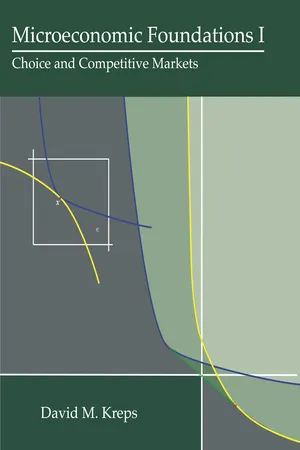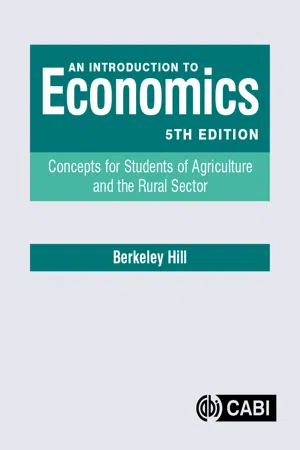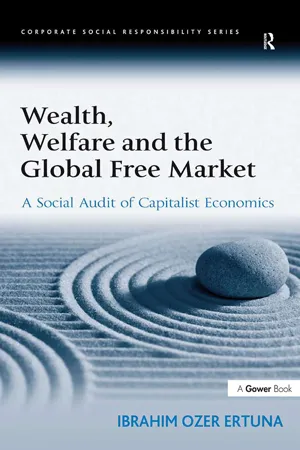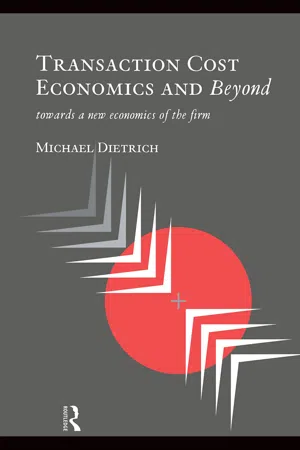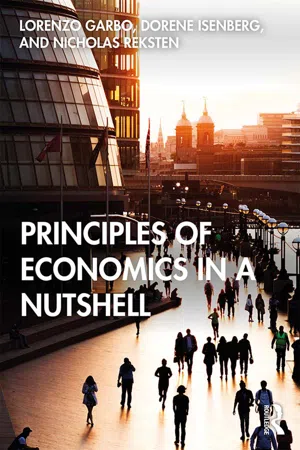Economics
Profit Maximization
Profit maximization is the process by which a company aims to achieve the highest possible level of profit. This involves determining the optimal level of output and pricing to maximize revenue while minimizing costs. In practice, firms often use various strategies such as cost-cutting, pricing optimization, and production efficiency to pursue profit maximization.
Written by Perlego with AI-assistance
Related key terms
Related key terms
1 of 4
Related key terms
1 of 3
9 Key excerpts on "Profit Maximization"
- eBook - ePub
Microeconomic Foundations I
Choice and Competitive Markets
- David M. Kreps(Author)
- 2012(Publication Date)
- Princeton University Press(Publisher)
It is impossible to do justice to this literature here, without expanding this chapter unreasonably and, in any case, some of the answers require pieces of economics that we haven’t yet studied. So I’ll plead simply that Profit Maximization is a modeling assumption, one with which economists are comfortable not as a law of nature but as an approximation to reality. Having said that, three specific points are worth making, albeit briefly. • Profit Maximization as an objective function for firms is a lot more specific than utility maximization for consumers. When we assume that a consumer maximizes her utility, we leave it up to the consumer how she feels about apples versus oranges. But, once prices are given, the trade-offs facing a firm are fixed if the firm maximizes profit. (On the other hand, the choice set of a consumer is fixed once prices are fixed and the consumer’s income is given. For firms, the production-possibility set Z gives a lot of latitude to the modeler.) • Accounting earnings or income is not economic profit. Accounting income does not include any return on capital equipment. • The arguments in the literature for Profit Maximization when there is a division between managers and owners of the firm turn to some extent on a contention that managers act on behalf of the firm’s owners, who prefer Profit Maximization. Why managers do this is usually the issue being studied in the literature. But it is worth noting that the assertion that owners prefer Profit Maximization is very bound up in the assumption that the firm has no impact on prices - eBook - ePub
- John H Hoag(Author)
- 2012(Publication Date)
- WSPC(Publisher)
What difference would there be between firms acting to minimize cost compared to maximizing profit? Firms should try to minimize cost regardless of the output produced. Profit Maximization is a strategy to choose the level of output to produce. Here is the citation for this study: Loren Tauer, “Do New York Dairy Farmers Maximize Profits or Minimize Costs?”, American Journal of Agricultural Economics, Vol. 77, No. 2, May, 1995, pp. 421–429. Section Summary: In this section, we have seen that from the marginal curves alone, we cannot determine the amount of profit the firm makes. To find profit, we need some added curves: the average curves. In addition, we have developed the shutdown condition, and illustrated it as well. In the next section, we will combine the Profit Maximization proposition and the shutdown condition to find the firm’s supply curve. 5.6 The Competitive Firm’s Supply In this section, we combine the Profit Maximization proposition and the shutdown condition to obtain the competitive firm’s supply curve. This will provide the construction of the second big concept in economics: supply. We start with a definition of the concept we are seeking. Definition 5.10: The firm’s supply curve is a relationship between output and dollars per unit of output showing the number of units a firm would choose to produce and sell at each price with input prices and technology not changing. The definition is about the choices that the firm makes. We know that the firm acts to maximize profit. Hence, we can now look at quantities the firm would choose to produce at each price. Of course we know that at some prices the firm will decide to shut down, so we will have to take that into consideration as well. Consider Figure 5.8. Figure 5.8 In the left graph, we have the firm choosing the profit-maximizing output at a variety of prices. We bring the prices and the associated quantities to the graph on the right to find supply - eBook - ePub
An Introduction to Economics
Concepts for Students of Agriculture and the Rural Sector
- Berkeley Hill(Author)
- 2021(Publication Date)
- CAB International(Publisher)
The relative ease with which monetary profit can be measured, and hence the success or failure of a management decision assessed, has led to areas of the subject becoming highly mathematical. However, here the use of mathematics is minimal.Production economics recognizes that in practice firms do have other objectives (or goals) besides profit. These were discussed in relation to the Theory of Supply (Chapter 3 ) and included the avoidance of risk, the prestige of the business and the personal preferences of the operator. For the sake of simplicity, however, production economics assumes that the sole objective of production is the maximizing of profits. Non-profit motives can be incorporated later.Also for simplicity we will also assume that the firm is managed and run by a single person who also owns the business and who benefits if it makes a profit or who loses if it does not; this person is called the ‘entrepreneur’. As we will see later, this simple business form is common in UK and EU agriculture, though partnerships and other forms are also found in which the responsibilities for decisions are shared (see Chapter 6 ). The resources at the entrepreneur’s disposal to generate profit are the firm’s stock of capital assets (machinery, buildings, etc.), its raw materials, its labour force and land, and its management capacity (which in our simple model may just be the farmer). The entrepreneur must allocate and organize the other resources so that they are used in the best possible way – that is, so that the highest profit possible is generated from them.Production economics is often called the Theory of the Firm because it attempts to explain the behaviour of profit-maximizing firms and can be adequately described by modifying the general definition of economics given in Chapter 1 of this text.Production economics, or the Theory of the Firm, is the study of how firms allocate their scarce resources between alternative uses in the pursuit of Profit Maximization.Questions facing the entrepreneurIn the pursuit of profit an entrepreneur will have to make three major decisions: (i) what to produce; (ii) how to produce it; and (iii) how much to produce. To a large extent the resources at his or her disposal, including the entrepreneur’s own management preferences and abilities, will answer these questions. For example, a farmer with land, labour, a stock of machinery and access to a certain amount of borrowing from banks, etc. will naturally not consider producing motor cars or television sets because he does not have the right types or quantities of resources required. Only products lying within the farmer’s range of abilities and resources will be considered. - eBook - ePub
Wealth, Welfare and the Global Free Market
A Social Audit of Capitalist Economics
- Ibrahim Ozer Ertuna(Author)
- 2016(Publication Date)
- Gower(Publisher)
costs of the products sold consist of both the costs of input materials and the factor costs. That is, the costs considered are costs of materials, labor, capital, and all relevant costs pertaining to the production and sale of the products. Again, under the assumptions of economics, the costs of additional production and sale follows first a decreasing, then an increasing trend. The additional cost is called “marginal cost” in economics. Since profit is the difference between revenues and costs, as it is commonly known, profit is maximized when the marginal revenue is equal to the marginal cost. This profit-maximization rule of economics is the best-known rule of economics. But, profit defined in this way is not something approved of in economics. Because, this profit earned is in excess of the earnings from the factor inputs. It is a return without an input; therefore it is not justified. As we have said before, some people justify this profit by considering it to be the return for entrepreneurial skill.According to capitalist theory, profits arise only in monopolistic markets; or if the companies have monopolistic powers to manipulate the markets. The monopolistic markets in the theory are the markets where there is only one seller who sells a product, which has no substitute, with barriers to entry. Since the theory does not approve of profits defined in the above way, in capitalistic economies, there are rules and regulations to eliminate monopolies and to prevent the development of monopolistic power and to constrain monopolistic behaviors.According to the capitalist free market economy, profits do not arise in purely competitive markets. In markets that are fully competitive, only a homogeneous product is traded among a great number of buyers and sellers, none of whom is able to influence the market. It is also assumed that in these markets there is no barrier to entry, transportation costs do not exist and there is full information on anything relevant to the markets. Under these assumptions, the competition among sellers will eliminate profits, costs will be minimum, and the price, marginal revenue, average cost and marginal cost will all be the same. In perfectly competitive markets, there would be no profit or income that is not deserved. - Sandip K. Lahiri(Author)
- 2020(Publication Date)
- Wiley(Publisher)
4 Strategy for Profit Maximization4.1 Introduction
Profit Maximization is usually the top priority of a company's top management. However, many external and internal factors influence a company's profit. Most of the external factors like international price fluctuation of raw materials and final products, and price variations of utilities and chemicals are usually beyond the control of the company's management. However, production costs, energy efficiency, and process and equipment efficiency can be influenced by a company's operating persons. In such a case, Profit Maximization essentially boils down to minimization of the cost of production. In some chemical plants, cost optimization work falls into no man's land. However, all the operating persons starting from plant operators, production engineers, and supervisors feel that they are operating the plant in the most cost‐efficient way. The reality is that there is a large scope for cost efficiency improvement. To find out the truth, you may ask a few questions: What key performance index (KPI) is applied to measure the cost efficiency? How is profit tracked and monitored on a real‐time basis? What cost indicators are defined for the key equipment? How do you set up targets for these indicators (Zhu, 2013 )?The quality of answers to these four questions will indicate whether the plant management only has good intentions but without a proper measure in place. If no profit or cost matrices are used to measure the performance level, no KPIs are applied for major processes or equipment, and no targets are employed for monitoring or identifying improvement, then a Profit Maximization program is only on the basis of good intent but without foundation. If you cannot measure profit in real time, you cannot control in real time. A good foundation needs to be built first before building a castle on it. It is possible to get people motivated with good intentions or with a big vision of management. However, to sustain that motivation, plant people need to know what to do and what is the right direction to maximize profit (Zhu, 2013- eBook - ePub
- Gary Becker(Author)
- 2017(Publication Date)
- Routledge(Publisher)
Traditionally, a firm is assumed to maximize its income, often called “profits,” defined as the difference between receipts in product markets and outlays in factor markets. The maximization is constrained by a production function that shows the relation between inputs and outputs, and by demand functions in product markets and supply functions in factor markets. Profits are assumed to be spent on consumption goods according to the theory of demand set out in the previous lectures. The assumption of Profit Maximization amounts, therefore, to a separation of production from consumption: the former is done in firms and the latter in households.Several developments in recent decades have stimulated a significant modification of the theory of the firm away from Profit Maximization. Perhaps the most important is the spread of government-owned and regulated enterprises even in capitalist countries and, of course, more so in other countries. In addition, “nonprofit” private firms have multiplied as education, health, and other service industries have increased their share of output. Economists have also developed a greater awareness of nonprofit motives in “commercial” firms; these motives include an interest in nepotism, discrimination, and size per se. Moreover, the new approach to household decision-making brings production into the household, and sets an example for the theory of the firm.A natural way to incorporate these developments is to replace Profit Maximization by utility maximization. A firm may act as if it maximized a utility function that depends not only on profits, but also on the color, sex, and family background of employees; level of outputs; market shares; and so on:U = U ( I ,y 1, ... ,y n,q 1, ... ,q m, V ) ( 15.1 )where I is profits,yiandqiare characteristics of inputs and outputs, and V stands for other variables. We could replace I by the commodities produced by households receiving I , and even theyiandqicould be replaced by the commodities they help to produce. Since only indifference curves are relevant for behavior, any order-preserving monotonic transformation of U - eBook - ePub
Microeconomics
A Global Text
- Judy Whitehead(Author)
- 2014(Publication Date)
- Routledge(Publisher)
PPF ), the slope represents the opportunity cost of one good in terms of the other. The slope therefore gives the ratio of the marginal cost of the two goods. Hence, in practical terms, the equilibrium condition indicates that the producer should ensure that the incremental cost (marginal cost) of producing each of the goods is proportional to the price of the goods or that:This extends to any number of goods and is vital to the producer being able to produce efficiently and attain the level of competitiveness required in an internationally competitive market.Review Questions for Chapter 5
- Explain in detail how Profit Maximization can be achieved for a firm in the Short-run showing why the producer must operate in ‘zone 2’ of the production function.
- Derive the Long-run profit maximizing condition for a firm that is:
- (a) Not constrained (by output or cost)
- (b) Constrained by cost
- (c) Constrained by output
- With regard to a multi-product firm producing two products, and using two factors of production:
- (a) Show how the technique of the Edgeworth Box may be used to identify the most technically efficient combination of outputs.
- (b) Derive the production possibilities curve from the contract curve in the Edgeworth Box.
- (c) Show how iso-revenue curves may be constructed.
- (d) Carefully illustrate how the product transformation curve and the iso-revenue curves may be used in determining the Profit Maximization combination of outputs for the firm.
Multiple choice questions
Indicate the single correct answer for each of the following questions.- In the short-run a producer has a production function Q = f (L )K where output (Q ) is a function of the labour input (L ) with all other factors (represented by capital (K
- eBook - ePub
Transaction Cost Economics and Beyond
Toward a New Economics of the Firm
- Michael Dietrich(Author)
- 2008(Publication Date)
- Routledge(Publisher)
It will be argued in that this introduces a significant role for government policy which is not usually recognised within economics. DEFENCE 4: PURPOSE OF THE THEORY This final defence of profit maximisation has been suggested by, among other people, Penrose (1980). She argues that the firm, qua the theory of the firm, should not be confused with an organisational firm because the former is one element in a theory of markets and price determination. It follows that the profit maximising firm can only be criticised within these terms of reference. This defence of profit maximisation is the only one of the four presented in this chapter that is considered acceptable. But this acceptance introduces a series of further matters that must be discussed. To claim that the profit maximising firm is a universal theoretical benchmark implies either that the only matters of relevance in economics are prices and markets, 3 which dismisses the possibility of any wider institutional analysis, or that the profit maximising firm is useful in all circumstances which can of course be argued but not assumed. Discussion earlier in this chapter clearly signalled that the firm as a governance structure or organisation is not the same theoretical entity as a profit maximising firm, and furthermore the two are not comparable in any obvious way. Conventional analyses of price determination are based on demand and supply interaction given particular market structures. Within a more contractual or organisational framework prices can be viewed as one of the outputs of managerial activity. Any attempt to map one perspective on to the other, by for example following the Williamsonian method discussed above, is not valid unless the theoretical issues involved with this mapping are taken into account. The sorts of confusions that can be introduced if the particular theoretical status of the firm is not explicitly recognised have been indicated in this chapter - eBook - ePub
- Lorenzo Garbo, Dorene Isenberg, Nicholas Reksten(Authors)
- 2020(Publication Date)
- Routledge(Publisher)
every input gets fully paid at the current rates or wages. You may wonder: why bother to own this firm if the firm is just breaking even? Well, if the owner of the firm owns all or part of the capital stock (machinery, space, and so on), then the owner will receive a normal return from the investment in that capital stock. And if the owner actually works in the firm, the owner will also receive the appropriate compensation for her/his labor. The firm just “makes enough” to cover all the costs without losing and without gaining anything extra (no economic losses, no economic profits).Take a moment to reflect on these different concepts of profits. What does it mean to a firm’s operation if it is not making a normal profit? Now, how would you describe the other profit situations?
In order to analyze the decision-making process that leads to the firm’s maximization of profits, we need to become very well acquainted with the determinants of Total Revenues and Total Costs.4.4A survey of market structuresLet’s begin our analysis with total revenues. We have already encountered this concept when we talked about the price elasticity of demand in Chapter 3 : total revenues consist of the “money” the firm obtains by selling its output, i.e., TR = P * Q, where “P” is the price of each unit of output, and “Q” is the firm’s output. Thus, if the firm is a hair salon that produced 200 haircuts (Q = 200) sold at $30 each (P = $30), the total revenues of the hair salon turns out to be $6,000.A key question we need to look at is: if the firm changes the quantity produced, does the firm affect/change the price at which that quantity produced can be sold? Another way to ask this question is: does the price at which the firm can sell its product depend on how many units of the product the firm brings to the market? What is your intuition about this? If Apple doubles the number of iPhones supplied in the market, do you think that the price of iPhones will be affected? If a peasant with a small number of cows doubles the amount of milk supplied in the overall market of milk, do you think that the price of milk would be affected?You may have already come to the realization that the answer to these questions depends on how large the firm is in relationship to the market
Index pages curate the most relevant extracts from our library of academic textbooks. They’ve been created using an in-house natural language model (NLM), each adding context and meaning to key research topics.
Explore more topic indexes
Explore more topic indexes
1 of 6
Explore more topic indexes
1 of 4
